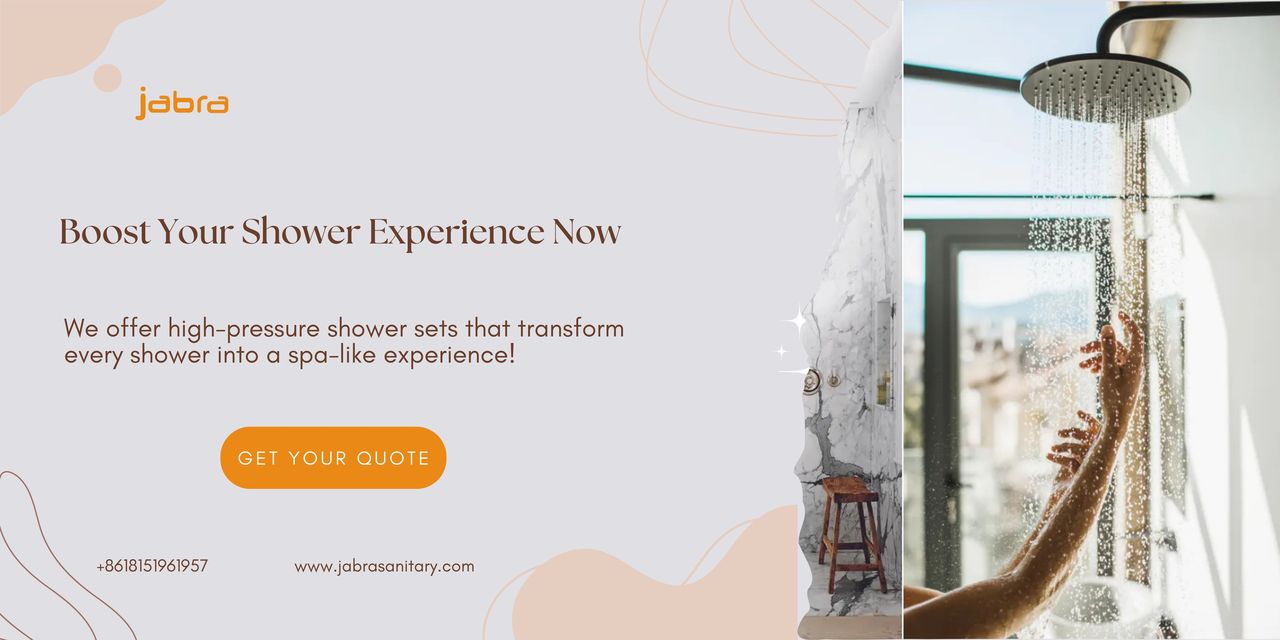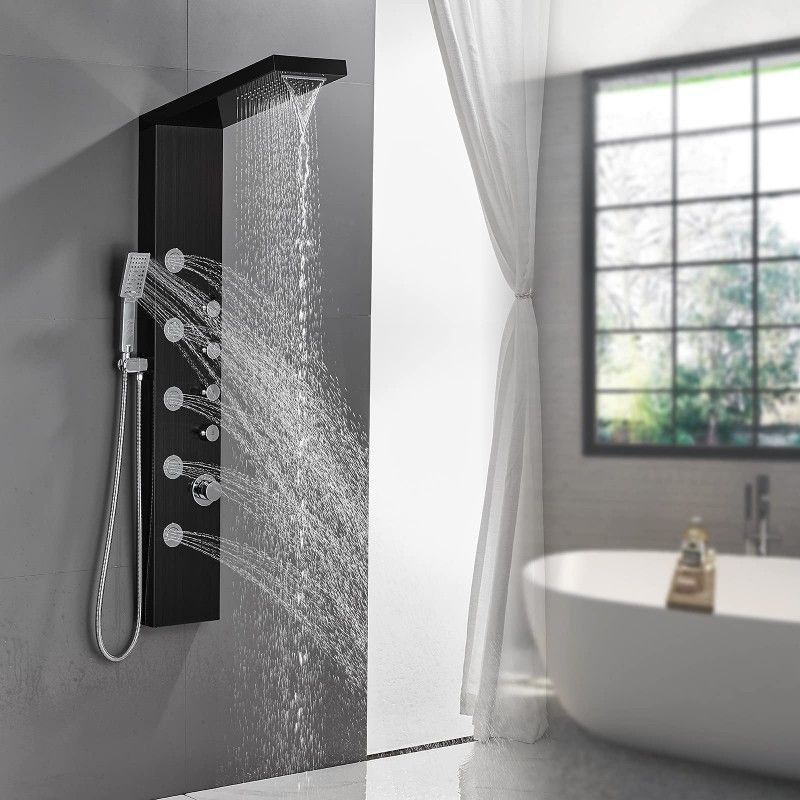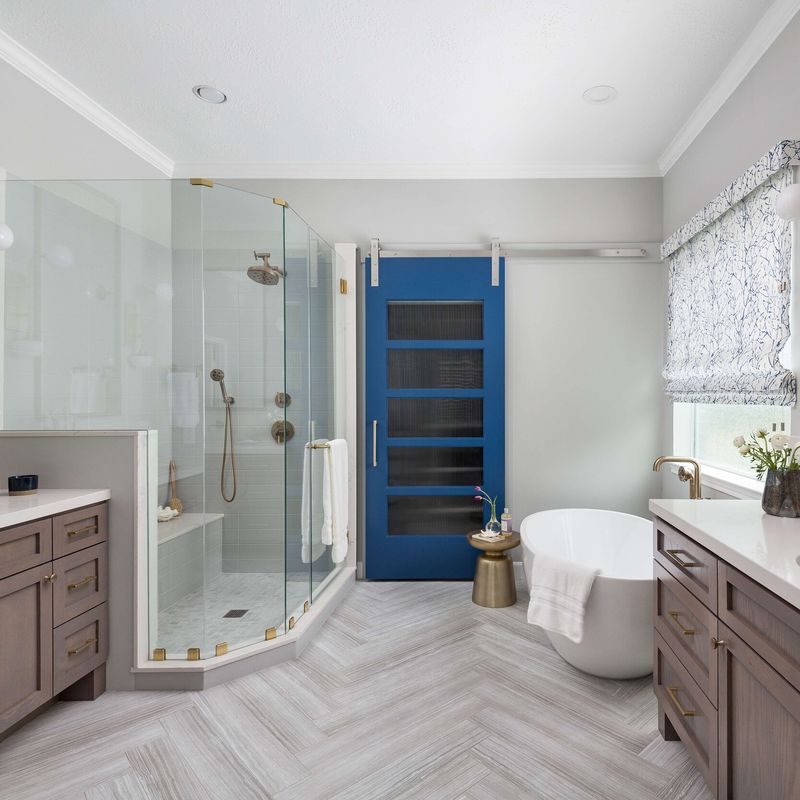 English
English
Jabra Sanitary is a sanitaryware supplier offering toilets, sinks, faucets, bathtubs, etc., at competitive prices. If you're a distributor, wholesaler, or project contractor, get a quote today!
 $23.9 Limited-time Offer
$23.9 Limited-time Offer Consignment Policy
Consignment Policy 20 Years of Experience
20 Years of Experience
Low water pressure in showers is a common problem. A weak shower stream makes it hard to rinse off soap and shampoo properly. It can make showering less effective and even affect one's mood.
Poor water pressure in the shower will disrupt your daily routine and result in a waste of water, affecting your bills and the environment.
Whether you live in an apartment or an older home, let's try to find the causes of low pressure in shower problems and how to fix these issues to improve your shower experience.
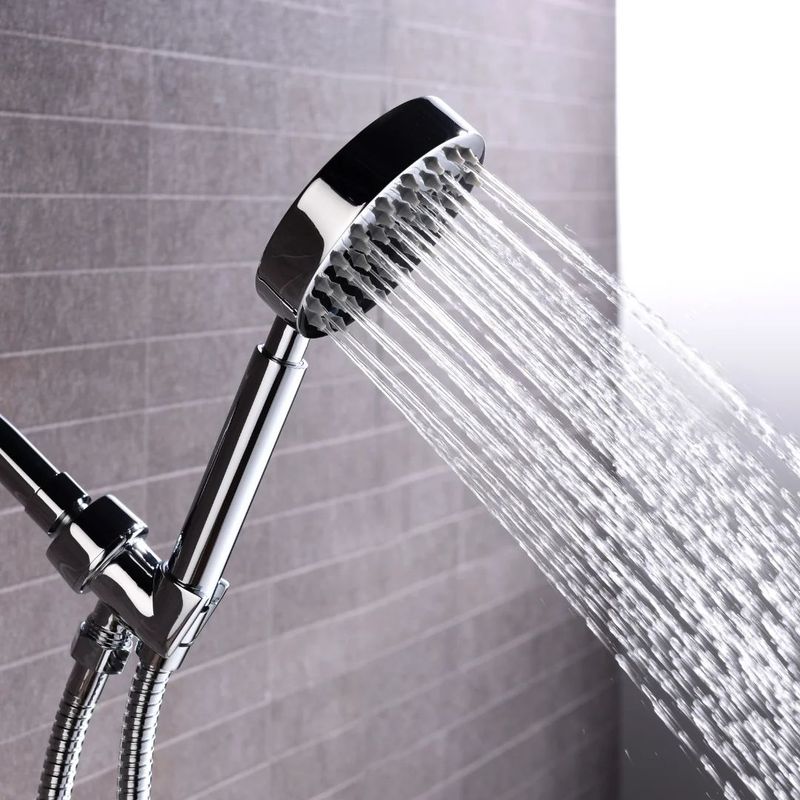
Table of Contents
What is Water Pressure
Why Is My Water Pressure Low in My Shower
Signs of Low Water Pressure in Shower
How To Improve Low Water Pressure In Shower
The Best Showers for Improving Water Pressure
How to Test Water Pressure in Showers
Tips for Preventing Low Water Pressure in Showers
8.Common Myths About Low Water Pressure in Shower
When to Call a Professional Plumber
The Cost of Increasing Water Pressure in Showers
FAQs
Conclusion
What is Water Pressure
Water pressure is the force exerted by water on surfaces or objects, typically due to the weight of the water above it or the flow within a pipe or system.
Water pressure is measured in bars, with 1 bar equal the pressure needed to push water 10 meters high. While water companies must provide a minimum pressure to homes, the exact pressure you get depends on factors like how far you are from the source, the local terrain, and how much water your neighbors are using.
Why Is My Water Pressure Low in My Shower
There are several common causes of low water pressure showers. Below are 9 major reasons why is the water pressure low in the shower that require to be checked first.
1. Clogged Showerhead
Minerals like calcium and lime can build up in the showerhead, especially in areas with hard water. This buildup blocks the nozzles, reducing water flow. Dirt and rust can also get trapped.
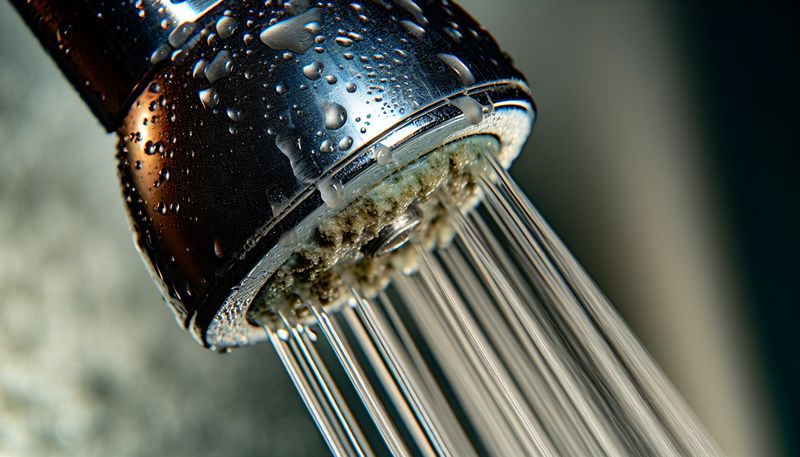
2. Pipe Corrosion
Old metal pipes can corrode over time, making the water flow slower. Rust and mineral deposits build up inside the pipes, restricting water.
If you have old galvanized steel or iron pipes, replacing them with copper or PEX can improve pressure.
3. Faulty Mixing Valves
A faulty mixing valve is a common cause of low water pressure in showers. Mixing valves are responsible for blending hot and cold water to achieve the desired temperature.
If the valve becomes damaged or clogged with mineral deposits, it can restrict the flow of water, leading to reduced pressure.
Here are some common issues caused by faulty mixing valves:
- Clogged Valves: Over time, mineral build-up from hard water can clog the valve, reducing the amount of water that flows through.
Worn-out Parts: The internal components of the valve, like seals or springs, may wear out, affecting its ability to function properly and causing pressure problems. - Incorrect Installation or Adjustment: If the valve is not installed correctly or has been improperly adjusted, it can lead to uneven water flow, resulting in low pressure.
4. Closed Valve
One common and often overlooked cause of low water pressure in the shower is a closed or partially closed valve. Valves are responsible for controlling the flow of water to different areas of your plumbing system, including your shower.
If a valve is accidentally closed or not fully opened, it can restrict the flow of water, leading to weak water pressure.
How Closed Valves Affect Water Pressure
- Main Supply Valve: If the main water supply valve to your home or to a specific plumbing line is partially closed, it can limit the amount of water entering your pipes, resulting in low pressure in the shower.
- Shower Diverter Valve: The diverter valve in your shower controls the flow between the faucet and the showerhead. If this valve is not fully open, it can cause reduced water flow, making the shower pressure feel weak. <See how to install shower faucets>
- Hot and Cold Water Valves: Showers typically have separate valves for hot and cold water. If either of these valves is partially closed, the overall pressure may drop, especially if you're trying to achieve a specific water temperature.
Common Causes of Closed Valves
- Accidental Adjustment: During routine maintenance, repairs, or cleaning, someone might inadvertently close a valve without realizing it. It's especially common in multi-valve systems where the hot and cold valves are separate.
- Valve Wear or Damage: Over time, valves can become worn out or damaged, causing them to malfunction and remain partially closed even when you think they are fully open.
- Water Pressure Regulator Issues: If your home uses a water pressure regulator, an issue with the regulator can cause a partial closure of valves, affecting water flow to certain areas.
5. Low-Flow Showerhead
A low-flow showerhead can contribute to low water pressure, but it's important to distinguish it from an actual pressure issue. Low-flow showerheads are designed to conserve water by restricting the amount that flows through, which can result in a gentler water stream.
While this is great for water efficiency, it can sometimes be mistaken for low water pressure.
Here's how a low-flow showerhead can affect your experience and lead to the low water presssure in showers problem:
- Reduced Water Flow: Low-flow showerheads are intentionally designed to use less water, usually by limiting the flow to 1.5 to 2.5 gallons per minute (GPM), compared to the 5 GPM used by older models. This reduction in flow can feel like low pressure, especially if you're accustomed to higher water output.
- Water-Saving Benefits: These showerheads are often installed by homeowners to save on water bills and reduce environmental impact. However, if you prefer a stronger shower stream, the lower water flow may not provide the satisfying pressure you're used to.
- Clogs or Build-Up: Even with a low-flow design, mineral build-up from hard water can clog the small openings in the showerhead, reducing water flow further and causing the shower to feel even weaker.
6. Municipal Water Supply Issues
Sometimes, the lower pressure in shower problem comes from outside your home. If the water supply is disrupted, like maintenance or repairs, it can lower the water pressure in your area.
If your neighbors are also having trouble, the issue is likely with the water provider.
7. Faulty Pressure Regulators
A Pressure Reducing Valve (PRV) helps control water pressure entering your home. If it's set too low or broken, it can cause low water pressure.
8. Plumbing Leaks
Leaks in your pipes can divert water away from the shower, lowering pressure. Even small leaks can cause issues.
9. Water Heater Problems
If only hot water has low pressure, the water heater might be the issue. Sediment buildup inside the tank can block water flow, and a faulty heating element or valve can also cause low water pressure in shower problems.
10. The Timing of Shower
Many people aren't aware that the timing of your shower can impact water pressure. During peak hours, such as 7 am to 9 am and 5 pm to 7 pm, water demand is highest, which can result in lower water availability and pressure.
Solution: Take Showers During Off-Peak Hours
By adjusting your shower schedule to off-peak hours, when fewer people are using water, you can enjoy better pressure and a more satisfying shower experience. This simple change is an easy and cost-effective solution for combating low water pressure.
Signs of Low Water Pressure in Shower
Low water pressure in the shower can show up in several ways. Recognizing these signs early can help you fix the low water pressure shower problem before it worsens.
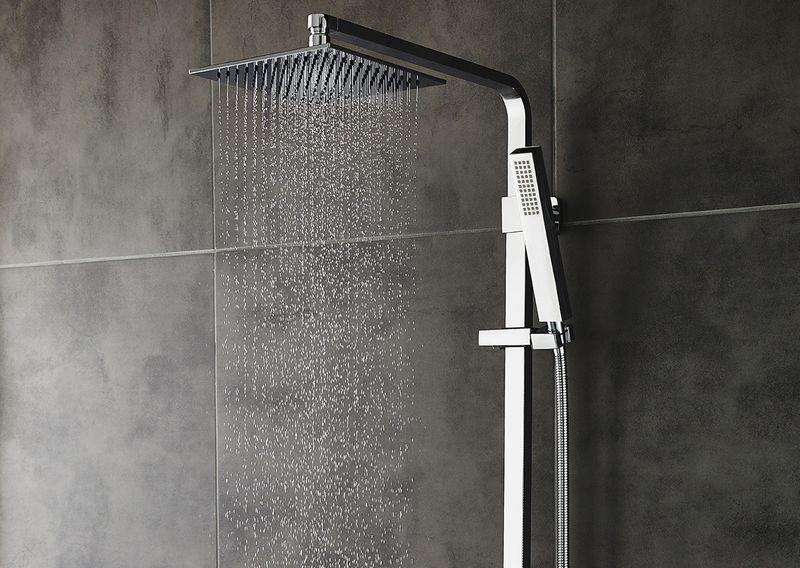
1. Reduced Water Flow
One clear sign of low water pressure is weak water flow. Instead of a strong, steady stream, you might only get a thin trickle of water. This makes rinsing off difficult and can make showers take longer.
2. Weak Spray from Showerhead
If your showerhead sprays unevenly or produces a weak stream, it could be due to low water pressure. Blockages from mineral buildup or plumbing issues can cause this.
If your shower spray isn't as strong as it used to be, it's a sign that the water pressure may be low.
3. Inconsistent Temperature
Low water pressure can cause the water temperature to fluctuate. You might feel sudden cold bursts while expecting hot water. This often happens when the pressure affects how the water heater works.
If this occurs only with hot water, it might indicate a problem with the water heater.
4. Leakage
One of the most common signs of a faulty showerhead is leakage. If you notice water dripping from the showerhead even when the shower is turned off, this is a clear indicator that something is wrong.
Possible causes of leakage include:
- Loose connection between the showerhead and the shower arm.
- Worn-out washers or seals, which are designed to prevent water from leaking around the connections.
- Cracked or damaged showerhead that may have developed holes over time.
A small, consistent leak can waste water and increase your utility bills, so it's important to low water pressure problem it as soon as possible.
5. Unusual Noise
If your showerhead is making strange whistling, hissing, or gurgling sounds while water is flowing, this may indicate a blockage or another issue.
Common causes of unusual noises include:
- Clogged spray nozzles or mineral buildup, which can restrict water flow and create noise.
- Water pressure issues: If your home has high water pressure, it can cause the showerhead to make whistling or buzzing noises as water struggles to pass through the nozzles.
- Air trapped in the pipes: Air pockets in the plumbing can create a "gurgling" sound as water flows over them.
If the noise is caused by a mineral buildup or a blockage, cleaning the showerhead or replacing it can help fix low water pressure shower. However, if it's related to water pressure, adjusting the pressure regulator may be necessary.
6. Visible Mineral Accumulation
Another clear sign that your showerhead may be faulty is visible mineral buildup. This is especially common in areas with hard water, where dissolved minerals like calcium and magnesium can accumulate over time.
If you see:
- White or chalky spots on the surface of the showerhead.
- Blockages in the nozzles, cause uneven water flow or low pressure.
This buildup can reduce water flow, clog spray nozzles, and cause an inefficient shower.
How To Improve Low Water Pressure In Shower
There are several ways to fix low water pressure in the shower, from simple cleaning to specialized and sophisticated fixes. Here are how to increase shower pressure to get better shower pressure.
1. Check First
Before jumping into potential solutions for low water pressure in your shower, it's important to check whether the issue is affecting other areas in your home. <Check how to increase water pressure in kitchen sink>
This helps you determine whether the problem is isolated to the shower or part of a broader plumbing issue.
Here are some things to check:
a. Is the Water Pressure Affected Anywhere Else in Your House?
Test other faucets and fixtures around your home to see if they also have low water pressure. If you notice a drop in water pressure across multiple fixtures (like sinks, toilets, or other showers), then the issue is likely with your entire plumbing system, not just the shower. <From reddit: Entire house has good water pressure except shower>
b. Do the Sink Taps in the Same Bathroom Have Low Water Pressure?
Check the sink faucets in the same bathroom where your shower is located. If both the shower and the sink have low pressure, the problem could be due to clogged pipes, a shared valve, or a plumbing issue in that specific bathroom.
If the bathroom sink faucet works fine while the shower has low pressure, this suggests that the issue is isolated to the shower's plumbing, such as a clogged showerhead or a faulty valve.
c. Is the Pressure Low for Both Hot and Cold Water?
Pay attention to whether the low pressure is occurring for both hot and cold water. If the water pressure is only low for one temperature, it could be a sign of a problem with your hot water system, such as a failing water heater or a clogged hot water pipe.
If the pressure is low for both hot and cold water, this indicates a more general problem, such as low water supply or issues with your home's plumbing system.
2. Clean the Showerhead
Minerals and debris can clog your showerhead. Cleaning the showerhead regularly can help maintain good water pressure. Regular cleaning can help remove mineral deposits or debris that might restrict water flow.
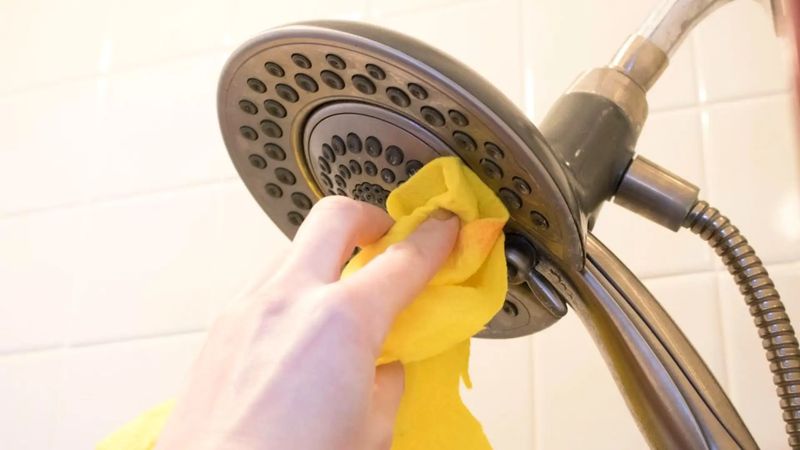
Here are how to clean up it:
- Remove the showerhead.
- Soak it in vinegar and water for 30 minutes.
- Scrub away any remaining buildup with a small brush.
- Rinse and reattach the showerhead (improving water flow).
3. Replace the Pressure Regulator
A faulty Pressure Reducing Valve (PRV) can lower water pressure. You might need to adjust or replace the PRV to fix the problem. Consult a plumber for proper installation.
4. Fix Plumbing Leaks
Leaks divert water away from your shower, causing low pressure. Fixing leaks quickly can address low water pressure in the tub.
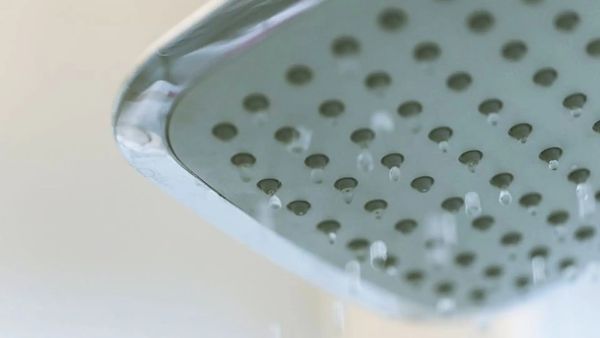
Here are how to fix leaks:
- Check pipes for damp spots or leaks.
- Listen for running water when no faucets are on.
- If you find a leak, turn off the water and patch it or call a plumber.
- Maintenance tips: Look for signs like damp spots on walls or ceilings, a higher water bill, or the sound of running water.
5. Upgrade or Replace Old Pipes
If you have old galvanized steel or iron pipes, replacing them with copper or PEX can improve pressure. While this is a bigger investment, it's worthwhile in the long run.
6. Install a Shower Booster
A shower booster is a small pump that increases water pressure in your shower. It's easy to install and can boost water flow if your home's overall pressure is fine but the shower is weak.
7. Check the Water Heater Functionality
If the hot water pressure is low, your water heater may be clogged with sediment. Regularly flush the tank and check the heating element. If the heater is old, consider upgrading it.
Regular maintenance can prevent these issues and ensure good hot water pressure.
Please notice that increasing water flow in the shower head can enhance your showering experience and may even help reduce the overall time you spend in the shower.
However, it's important to remember that a higher flow rate can quickly deplete your hot water supply, particularly if you have a traditional tank-style water heater instead of a tankless and on-demand heater.
8. Install a Pressure Booster Pump
A pressure booster pump can increase water pressure throughout your home. It requires professional installation and may raise your utility costs slightly.
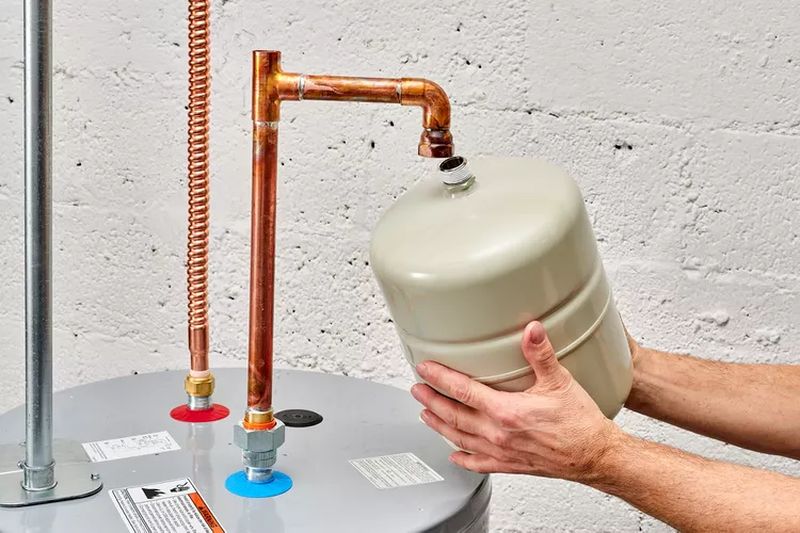
9. Choose a High-Pressure Showerhead
Check the Flow Rate: If you suspect the low-flow showerhead is the issue, check its specifications to ensure it's within the standard flow range.
You may consider switching to a showerhead with a higher flow rate if you prefer more pressure.
A high-pressure showerhead is designed to work even in homes with low water pressure. Look for models with air-infused streams or adjustable settings to improve the flow without using extra water.
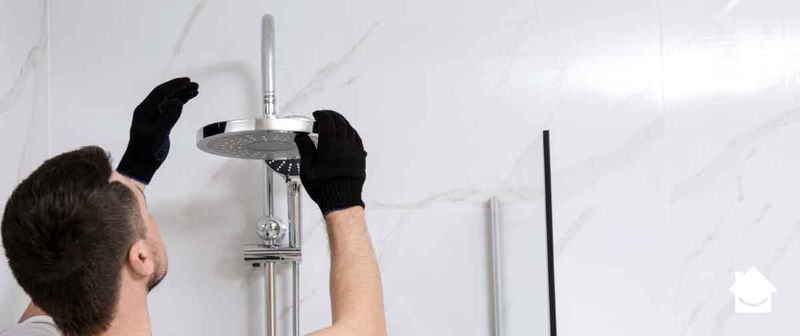
10. Use a Shower Water Pressure Regulator
A shower pressure regulator keeps water pressure consistent. If pressure fluctuates often, this device can help stabilize it for a more reliable shower experience.
11. Solutions for Faulty Mixing Valves
- Cleaning the Valve: Regular maintenance, such as cleaning the valve, can help prevent clogs caused by mineral deposits.
- Replacing the Valve: If cleaning doesn't solve the problem, you may need to replace the faulty valve with a new one.
- Professional Inspection: For persistent issues, it's a good idea to have a plumber inspect the mixing valve and the entire shower system for any underlying problems.
Warning: If the valve or the pipes near it look rusty or are hard to turn, call a plumber. Trying to force it could break the valve or pipe, causing a flood. Always call a professional if you're unsure.
12. Solutions to Fix Low Pressure from Closed Valves
- Check and Open All Valves: Start by checking all the valves leading to the shower, including the main water supply valve, the shower diverter valve, and both hot and cold water valves. Ensure they are fully open.
- Inspect for Leaks: If a valve is difficult to open or appears stuck, there might be a leak or blockage in the system. In such cases, a plumber may need to inspect and replace the faulty valve.
- Regular Maintenance: Periodically check all valves in your plumbing system to ensure they are functioning properly. Regular maintenance can prevent valves from becoming stuck or difficult to operate, reducing the chances of low water pressure.
- Call a Professional: If you've checked all valves and the issue persists, it may be time to call a plumber. There could be an issue with your plumbing system or water pressure regulator that requires professional attention.
13. Install a Water Softener
Installing a water softener can help prevent this problem and improve water pressure.
Steps to Install a Water Softener
a. Determine the Right Water Softener for Your Home:
Water softeners come in different sizes and capacities, depending on the size of your household and the hardness of your water. Choose a system that is appropriate for your needs. You can find the hardness level of your water through a water test or by checking with your local water utility provider.
b. Select the Installation Location:
The water softener needs to be installed where the main water supply enters your home, so it can treat all incoming water. Common locations include basements, utility rooms, or near the water meter.
c. Install the Water Softener:
- Turn off the water supply to your home before starting the installation.
- Follow the manufacturer's instructions to set up the water softener. This typically involves connecting it to your home's water supply using plumbing fittings.
- The softener will need to be hooked up to a drain for the waste water, which contains the minerals that have been removed from the water.
- If you're not comfortable with plumbing work, it's a good idea to hire a professional plumber to install the water softener.
d. Add the Salt or Potassium:
Water softeners require salt (or sometimes potassium) to work. Add the recommended amount of salt to the brine tank to start the regeneration process, which refreshes the softener's filtering system.
e. Turn the Water Supply Back On:
After the softener is installed and set up, turn the water supply back on. You should notice an improvement in water quality and pressure over time as the softener continues to remove minerals from your water.
14. Install a Pressurised Unvented Cylinder
An unvented cylinder is a hot water storage tank that operates under pressure. Unlike traditional gravity-fed systems, which rely on a water tank in the loft, an unvented cylinder is directly connected to your mains water supply, which allows it to maintain a higher pressure.
The water inside the cylinder is pressurized, giving you consistent, strong water flow to your taps and shower.
Installation Considerations
- Professional Installation Required: Installing a pressurized unvented cylinder involves working with the mains water supply and ensuring compliance with building regulations, so it should be done by a qualified plumber or heating engineer.
- Water Pressure Check: Before installation, it's important to ensure your home has sufficient mains water pressure to support an unvented cylinder. A water pressure test should be carried out to confirm that your main pressure is adequate for the system.
- Expansion Vessel: Since water expands when heated, unvented cylinders require an expansion vessel to safely accommodate the increased volume and prevent damage to the system.
15. Remove the Water Restrictor
A water restrictor is a device built into many modern showerheads to limit water flow in order to conserve water. While this is great for reducing water usage and lowering utility bills, it can also be a cause of low water pressure in your shower.
If you're dealing with weak water flow and are looking for an easy way to increase your shower pressure, removing the water restrictor could be a simple and effective solution.
How to Remove the Water Restrictor
- Turn Off the Water Supply: Before you begin, ensure the water supply to your shower is turned off to prevent any accidental spills or leaks.
- Unscrew the Showerhead: Use a wrench or your hands to unscrew the showerhead from the shower arm. If it's tight, apply some gentle force, but be careful not to damage the threads.
- Locate the Water Restrictor: Once the showerhead is removed, you'll notice the water restrictor inside the base of the showerhead, where it connects to the shower arm. It's typically a small plastic disc or rubber ring with a series of holes in it. Some showerheads may have a mesh filter or a flow regulator inside.
- Remove the Water Restrictor: Using a pair of needle-nose pliers or your fingers, carefully remove the water restrictor. It should pop out easily with a little force. Be sure to keep it in case you ever want to replace it later, especially if you live in an area with water conservation regulations.
- Reattach the Showerhead: Once the restrictor is removed, screw the showerhead back onto the shower arm. Be sure it's tightened properly to avoid leaks. You can wrap some Teflon tape around the threads if needed to ensure a snug fit.
- Turn On the Water: After reattaching the showerhead, turn the water supply back on and test the water pressure. You should notice a significant improvement in the flow, and your shower should feel more powerful.
The Best Showers for Improving Water Pressure
How to improve low water pressure in shower? If your shower has low water pressure, choosing the right shower system can help improve your experience.
Tip: Before replacing your showerhead, check the rules in your area to make sure the new one is allowed.
For example, in California, showerhead flow rates have been reduced over time to save water. They went from 2.5 GPM (gallons per minute) to 2.0 GPM, and now to 1.5 GPM.
Here are the best types of showers to improve poor water pressure in the shower:
1. Electric Showers
Electric showers are ideal for homes with low water pressure because they heat water on demand with cold water supplied directly. Here is how they work:
- Instant Hot Water: They heat water as it passes through, providing a steady flow of hot water.
- Consistent Pressure: They maintain a constant pressure even if your home's plumbing has low pressure.
- Energy Efficient: These showers only heat the water you use, saving energy.
2. Mixer Showers
Mixer showers combine hot and cold water from your existing plumbing system to give you the right temperature. Here are the features of them:
- Balanced Flow: They work well with both high and low pressure.
- Variety: You can choose between manual or thermostatic models. Thermostatic models keep the temperature stable, even if other taps are in use.
- Pump Compatibility: You can add a pump to boost pressure for an even stronger shower.
3. Digital Showers
Digital showers use advanced technology to control water temperature and flow. Here are the advantages of them:
- Smart Control: You can adjust the shower's temperature and pressure using a control panel or app.
- Boosted Performance: Many models have built-in pumps that improve water pressure.
- Convenience: Features like remote control and preset temperature settings make these showers easy to use.
4. Power Showers
Power showers are designed to boost water flow and pressure, offering a stronger, more invigorating shower experience, even in homes with low water pressure.
Benefits of Power Showers
- Increased Water Pressure: The primary advantage of a power shower is its ability to increase water pressure, providing a stronger and more consistent shower experience, even in areas with low municipal water pressure.
- Enhanced Performance: Power showers are designed to give you a high-pressure experience with better water flow, perfect for those who want a refreshing, powerful shower.
- Versatile Temperature Control: Many power showers allow for precise temperature adjustments, providing both comfort and efficiency.
- Ideal for Hard Water Areas: Power showers are also great for homes located in areas with hard water, as they can help combat the effects of mineral deposits that often clog up regular showerheads and reduce water flow.
How to Test Water Pressure in Showers
Before fixing low water pressure, it's helpful to test your water pressure. Here are three simple methods to check your water pressure in the shower:
1. Simple Flow Test
This quick test helps you estimate your shower flow rate.
Materials Needed |
A 1-gallon bucket and a timer. |
How to Do |
1. Place the bucket under the shower. |
Results |
The bucket should fill in about 6 seconds. If it takes longer (10-15 seconds), you likely have low water pressure. |
Tip: When you're talking about time, use decimals for minutes. For example, 2 minutes and 30 seconds should be written as 2.5, not 2.30.
2. Using a Pressure Gauge
A pressure gauge gives you an exact measurement of your water pressure.
Materials Needed |
A pressure gauge and possibly an adapter. |
How to Do |
1. Attach the gauge to a faucet or hose bib. |
Results |
Normal water pressure is 40-60 psi. Anything below 40 psi indicates low pressure. |
How Do You Read a Water Pressure Gauge
A water pressure gauge is a helpful tool for measuring the water pressure in your plumbing system. It tells you how much pressure is being exerted by the water flowing through the pipes, which is crucial for diagnosing low-pressure problems in your shower or throughout your home.
Here's how to properly read and understand a water pressure gauge:
a. Understand the Units of Measurement
Water pressure is usually measured in pounds per square inch (PSI), although some regions may use bars. In general:
1 bar = 14.5 PSI (pounds per square inch)
Most home plumbing systems are designed to operate between 40-60 PSI for optimal performance. Anything below 30 PSI is considered low, while pressure above 80-100 PSI may indicate a problem with your system or require adjustments.
b. Locate the Gauge
Water pressure gauges can be installed at various points in your plumbing system, depending on your needs. Common places to find a water pressure gauge include:
At the main water supply valve near where the water enters your home.
On the water heater, if you're troubleshooting pressure issues related to hot water.
A hose bib or faucet, as a more temporary setup to test water pressure.
c. Check the Reading
Once you have located the gauge, you can take the reading. The needle on the gauge will point to the current water pressure in PSI or bars.
d. Identify Fluctuations in Pressure
Occasionally, your water pressure gauge will show fluctuations. These variations may be normal, but if you see:
Sudden pressure drops: This could indicate a blockage, leak, or issue with the main water supply line.
Pressure spikes: This could be a sign of a malfunctioning pressure regulator or an issue with your water supply company.
e. Test Pressure at Different Times
To get an accurate reading, it's helpful to check the water pressure during different times of the day or under different conditions (e.g. when no water is being used in the house vs. when multiple fixtures are in use).
This can give you insight into how the pressure behaves under load, helping you pinpoint potential problems.
f. Using the Gauge to Troubleshoot Low Pressure
If you're troubleshooting low water pressure in your shower, follow these steps:
Take a reading at the main water supply valve. This tells you the overall pressure coming into your house.
Check the reading near the showerhead. If the pressure at the main valve is normal but the shower pressure is low, it indicates a localized issue—such as a clogged showerhead or a problem with the shower valve.
Look for pressure drops when other fixtures are in use. If pressure drops significantly when other faucets or appliances are used, the issue might be with your home's water supply system.
g. How to Adjust Pressure Using a Pressure Regulator
If your water pressure is too high, you can install or adjust a pressure-reducing valve (PRV) to bring it into the ideal range.
PRVs are typically installed at the point where the water enters the house and allow you to control and reduce the pressure. Some newer homes may already have a PRV installed.
3. Checking Pressure with a Multi-Outlet System
Test water pressure when multiple fixtures are in use.
| How to Do | 1. Turn on the shower to full pressure. 2. Run other water outlets, like kitchen taps or the washing machine. 3. Check the shower's pressure. |
| Results | If the pressure drops when other outlets are in use, your plumbing might need an upgrade to handle the load. |
Tips for Preventing Low Water Pressure in Showers
Preventing low water pressure is easier than fixing it later. Here are some tips for maintaining strong water pressure:
1. Regular Maintenance of Plumbing Systems
Regularly maintaining your plumbing can prevent low water pressure caused by mineral buildup, rust, or debris.
| How to Do | 1. Have a professional inspect your plumbing once a year. 2. Clean showerheads and faucets to remove mineral buildup. 3. Look for signs of leaks or pipe corrosion and fix them early. |
| Benefits | Helps prevent problems before they get worse and keeps water pressure steady. |
2. Check Water Pressure
Low water pressure can be a sign of a clogged showerhead or an underlying plumbing issue.
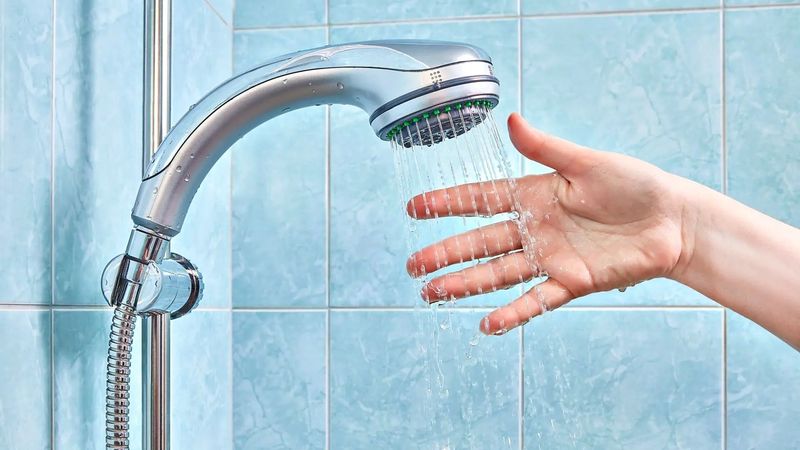
Regularly check your shower's water pressure to ensure it's consistent:
- Test the flow: Turn on the shower and see if the water comes out in a steady, strong flow. If it's weak or inconsistent, it could be due to mineral buildup or a clogged showerhead.
- Use a pressure gauge: If you're unsure, you can use a water pressure gauge to measure the pressure at the showerhead. This will help you determine if there's an issue with your plumbing or if
- it's time to clean the showerhead.
3. Regular Replacement of Parts
Over time, the parts of your showerhead may wear out or break down. Common parts that may need replacing include:
- Washers and seals: These parts can degrade, causing leaks or reducing water flow.
- Flow restrictor: If you've removed the flow restrictor for higher water pressure, you might want to replace it occasionally to ensure your showerhead operates efficiently.
- Spray nozzles: These can become clogged or damaged, so replacing them can restore the water flow and improve shower performance.
- Replacing worn-out parts is an inexpensive way to maintain your showerhead's functionality.
4. Avoiding Harsh Chemicals
While it may be tempting to use harsh cleaning products, they can damage the finish of your showerhead and weaken its components. Instead:
- Use mild cleaning agents like vinegar, baking soda, or gentle household cleaners that won't harm the surface.
- Avoid abrasive scrubbing pads that can scratch the surface of your showerhead.
- Check the manufacturer's instructions for specific cleaning recommendations for your showerhead model.
- Gentle, natural cleaning methods will help extend the lifespan of your showerhead without damaging it.
5. Install a Whole-House Water Filter
A whole-house filter helps remove minerals and debris, which can clog your pipes and reduce pressure.
| How to Do | 1. Choose a filter based on your water type (e.g., sediment filters for dirt). 2. Have a plumber install it at your main water line. |
| Benefits | Reduces buildup and keeps water pressure strong over time. |
6. Monitor Local Water Supply
Sometimes low water pressure showers is due to issues with the municipal water supply. Stay informed about changes in water pressure in the shower only.
| How to Do | 1. Sign up for alerts from your water utility for maintenance or pressure changes. 2. Check for public notifications about issues like water main breaks. |
| Benefits | Helps you know if low pressure is temporary or needs action. |
7. Avoid Overuse of Water
Using too many water outlets at once can strain your plumbing and lower water pressure.
| How to Do | 1. Stagger showers to avoid everyone using water at the same time. 2. Run appliances like dishwashers at off-peak hours. 3. Consider installing a water-efficient showerhead. |
| Benefits | Help maintain steady water pressure and avoid overuse. |
8.Common Myths About Low Water Pressure in Shower
There are several myths surrounding low water pressure in showers. One common misconception is that low water pressure shower is always a problem.
Another is that installing a high-flow showerhead will be better for life. However, the truth is not what people usually think.
1) "Low Pressure is Always a Problem"
Low water pressure isn't always a sign of a serious issue. It could be due to high water demand in your neighborhood at certain times of the day or from older plumbing systems.
Sometimes, it's a temporary pressure drop. Therefore, don't be too anxious about abrupt showers with low water pressure.
2) "Higher Pressure is Always Better"
Higher water pressure isn't always better. Excessively high pressure can damage water plumbs and increase water bills. It can also cause more frequent repairs.
The key is to find a balanced pressure for a comfortable and safe shower. If your pressure is too high, consider installing a pressure regulator.
When to Call a Professional Plumber
If you've tried fixing low water pressure on your own and the problem persists, it might be time to call a plumber. Here's when to ask experts for help:
1) Persistent Issues
If DIY fixes like cleaning the showerhead or checking the water valve don't work, the problem may be more serious. A plumber can diagnose hidden pipe issues, water supply problems, or a faulty pressure regulator.
2) Complex Plumbing Problems
Some issues, like pipe corrosion, leaks, or problems with your main water supply, require professional help. A plumber can find and fix these problems without damaging your property.
3) Inspection and Evaluation
If low water pressure is part of a bigger plumbing issue, a plumber can inspect the entire system. This can help identify problems like pipe damage, mineral buildup, or issues with the main water supply.
The Cost of Increasing Water Pressure in Showers
Whether you're cleaning your showerhead, replacing it, or making significant changes to your plumbing system, the price will vary depending on the method you choose. Here's a breakdown of the costs for the most common ways to increase water pressure in your shower:
- Cleaning your showerhead: Free to low-cost (£5)
- Replacing the showerhead: £10 to £100+
- Installing a shower pump: £100 to £500+
- Upgrading to larger water lines: £500 to £2,000+
- Installing an electric shower with a cold water accumulator tank: £200 to £600+
- Installing a power shower: £500+
FAQs
1) Is it okay to remove a restrictor from a showerhead?
Removing the restrictor can increase water flow and pressure but also has downsides:
- Pros: Stronger water flow and better pressure.
- Cons: Higher water bills, potential damage to plumbing, and possible legal issues in some areas.
Before removing a restrictor, weigh the benefits against the higher costs and potential plumbing issues.
2) What controls the flow of water in a shower?
The water flow is controlled by the shower valve (regulate water temperature and volume) and pressure regulator (control the overall water pressure coming into the shower).
3) Is shower pressure determined by the showerhead?
No, while the showerhead affects water flow, the pressure depends mainly on the water supply and plumbing. Issues like blockages, leaks, or pipe corrosion can lower pressure, even with a good showerhead.
4) Do all showerheads have flow restrictors?
Most modern showerheads have flow restrictors to save water and reduce bills. Some restrictors are removable or adjustable, but others are built-in. Choosing a higher-flow showerhead can help if you want stronger pressure.
5) What causes low water pressure in one shower but not the other?
If only one shower has low pressure, possible causes include:
- Local plumbing issues like blockages or leaks
- A clogged showerhead
- A faulty pressure regulator
- A partially closed water valve
Conclusion
Low water pressure in showers can stem from several common issues, including clogged showerheads, valve or pipe problems, malfunctioning pressure regulators, and water supply issues.
To resolve these problems, it's essential to clean showerheads, check and repair any faulty valves, inspect pipes for damage, and adjust the pressure regulator if necessary.
For basic issues, it is sensible to try simple DIY fixes like cleaning the showerhead or checking the valves.
However, if low water pressure in your shower persists despite your efforts, it's best to contact a professional plumber. They can accurately diagnose the issue and provide the necessary repairs.
No one wants to deal with low shower water pressure. A plumber can prevent further damage to your plumbing system and avoid costly repairs in the future.
Or partner with our shower factory. Jabra Sanitary delivers high-pressure power shower sets that transform every shower into a spa-like experience! Find our bathroom product at jabrasanitary.com.







